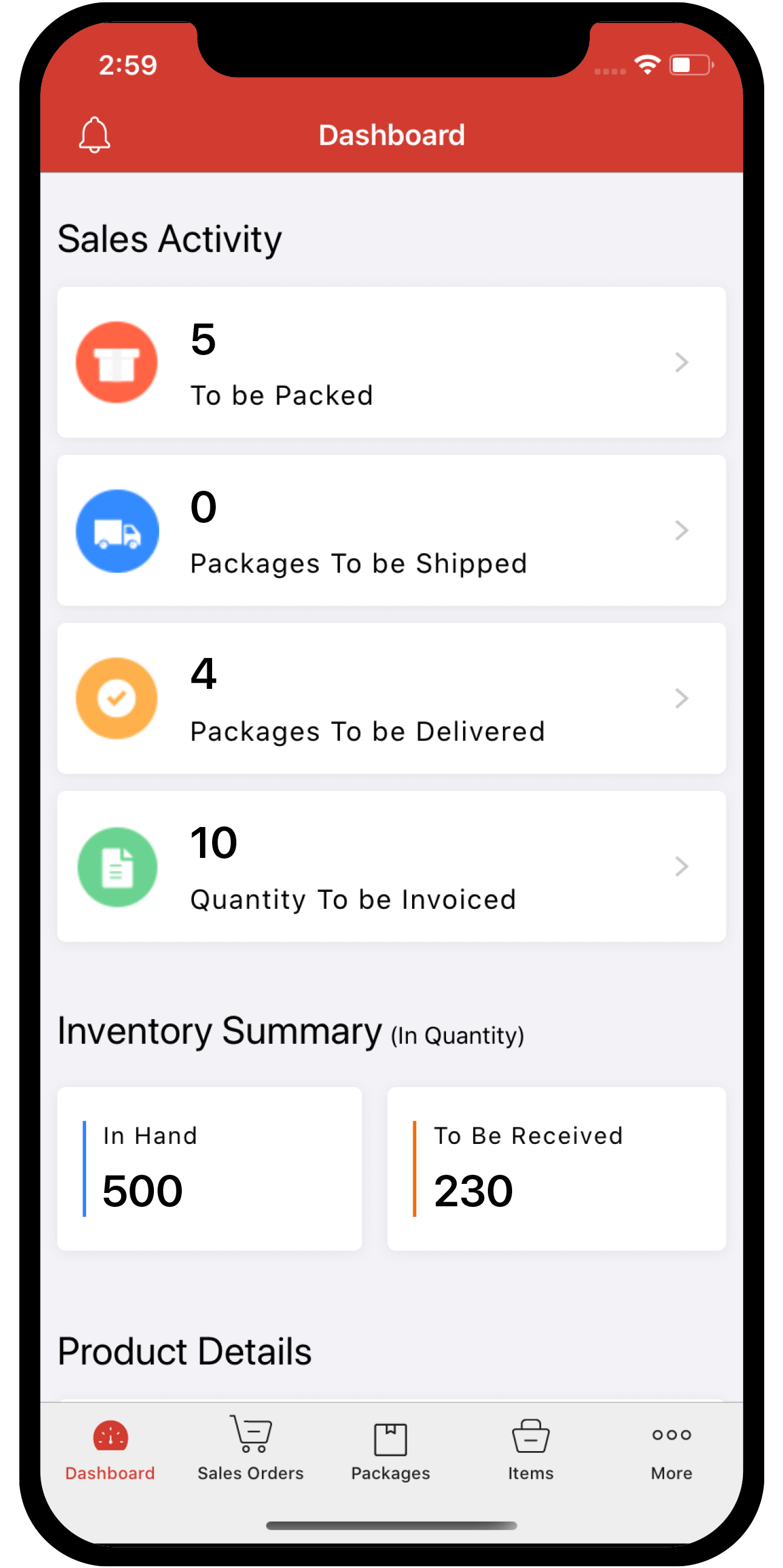 Inventory
Inventory
Functions in e-Invoicing
This guide will help you learn about the various actions you can perform in Zoho Inventory as part of e-Invoicing.
IN THIS PAGE…
Statuses of e-Invoicing in Zoho Inventory
Here are the various statuses related to e-Invoicing in Zoho Inventory.
| Status | Description |
|---|---|
| Yet-to-be Pushed | The transaction is yet to be pushed to the IRP for e-Invoicing. |
| Pushed | The transaction was pushed to the IRP successfully, and a QR code and IRN has been generated for it. |
| Push Initiated | The transaction is being pushed to the IRP as part of a bulk push action. |
| Cancelled | The e-Invoiced transaction has been cancelled in both Zoho Inventory and the IRP. The IRN associated with it is no longer valid. |
| Marked as Cancelled | The e-Invoiced transaction has been marked as cancelled in Zoho Inventory alone. You’ll have to cancel it in the GST portal to make the IRN invalid. |
| Push Failed | The transaction could not be pushed to the IRP. |
The e-Invoicing system requires the following transactions to be pushed to the IRP. An IRN will have to be generated for each of these transactions:
- Invoices
- Credit Notes
Insight: This guide explains how to push invoices to the e-Invoicing portal from Zoho Inventory. However, Credit Notes and Debit Notes can also be pushed in a similar manner.
Create Invoices
The Government has mandated a set of fields that are required for an e-Invoice. Some of these are available when creating new invoices. The other mandatory fields, will be available for that invoice if you’ve already entered them in Zoho Inventory (e.g. in the Customers or Items modules)
Here’s a list of some of the mandatory fields:
| Module | Mandatory Fields |
|---|---|
| Organisation (Seller) Details |
|
| Customer (Buyer) Details |
|
| Transaction Details(Invoice, Credit Note) |
|
| Item Details |
|
Other mandatory fields depend upon the business needs of the supplier. For example, the Dispatch From address is mandatory if it’s different from the seller address. The Shipping address is mandatory if it’s different from the buyer address.
Push Invoices to the IRP
Invoices in Zoho Inventory can be sent to the e-Invoicing portal with the click of a button. If you have enabled transaction approval, then the invoices must be approved before you can push them to the IRP. If you’ve set up a multi-level approval, then you can push invoices only after they’ve been approved by the final approver.
Note: You have to push an invoice to the IRP successfully before sending it to the customer.
Here’s how you can push invoices to the IRP:
- Go to the Invoices module in the left sidebar.
- Select the invoice that you want to push to the portal.
- Click the Push to IRP button.
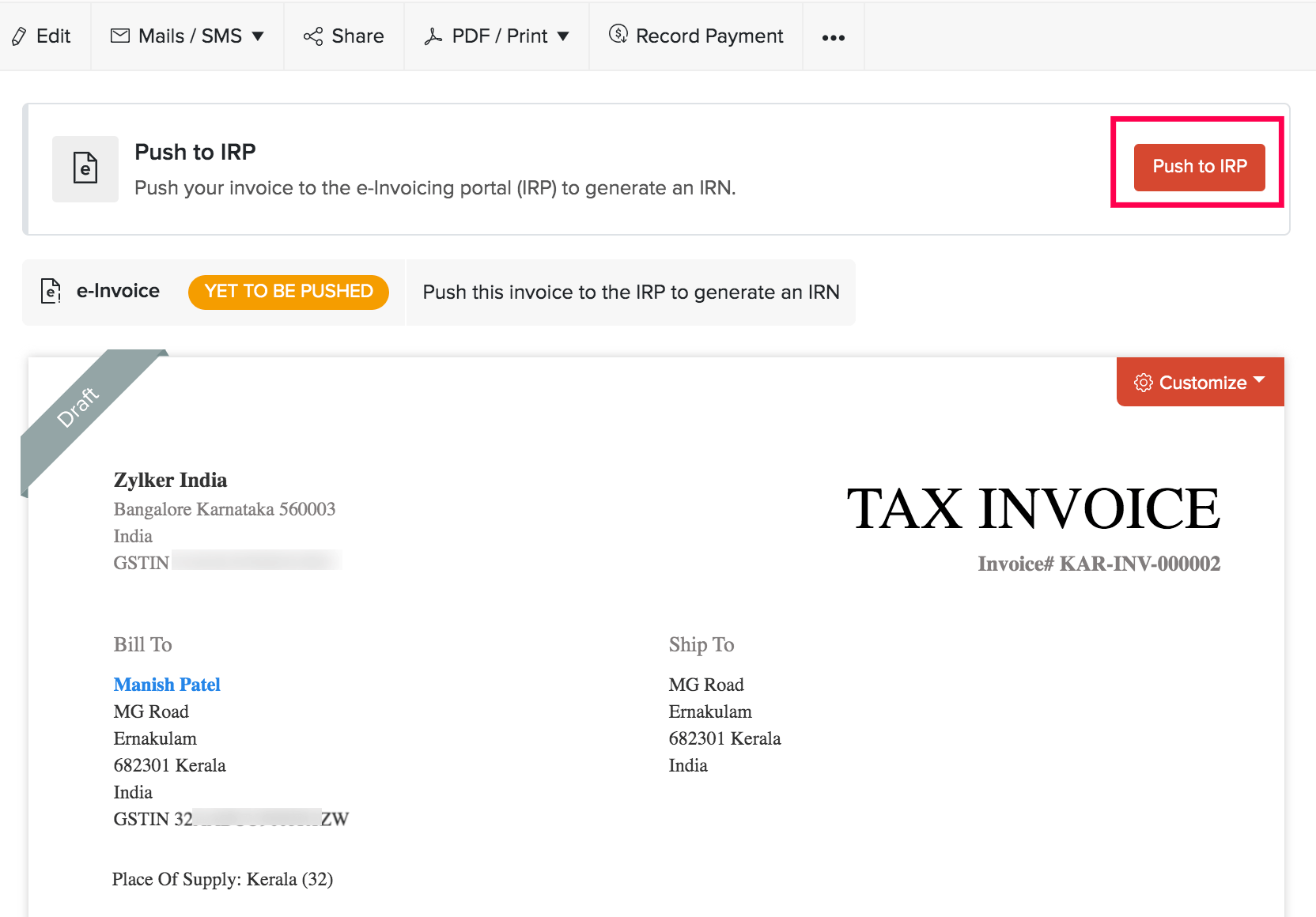
Push e-Way Bill Details
If you have enabled e-Way Bills in Zoho Inventory, then you can choose to push the e-Way Bill details to the IRP, along with your invoice. This way, you can save time and generate an e-Way Bill as well as an IRN for your invoice. When you click Push to IRP, you can decide which details you want to send to the IRP.
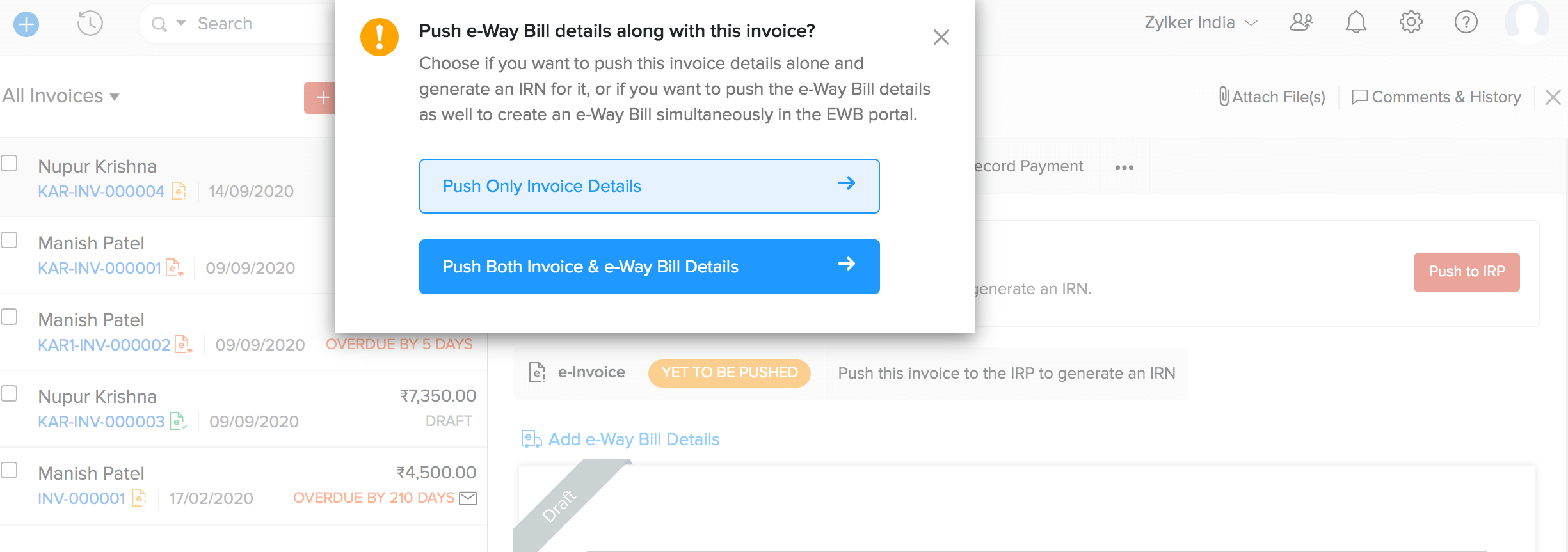
-
Push only Invoice Details: Your invoice will be pushed to the IRP and an IRN will be generated for it. Your e-Way Bill details will not be sent to the IRP.
-
Push Both Invoice & e-Way Bill Details: Both your invoice and e-Way Bill details will be sent to the IRP. If you’ve already entered the e-Way Bill details, then you can preview those details and push them along with the invoice. If not, you’ll be prompted to enter the e-Way Bill details, and then push them to the IRP along with the invoice.
If the invoice is pushed successfully, the IRP generates an IRN (Invoice Reference Number) and a QR Code. This IRN is used to uniquely identify each invoice for the entire financial year in the GST system. You can click Copy IRN above the invoice preview to copy this IRN if needed.
If you want to include this QR code and IRN in your invoice, you can do so by editing the invoice template. Here’s how:
-
Hover over the invoice template.
-
Click Customize.
-
Select Edit Template from the list of options.
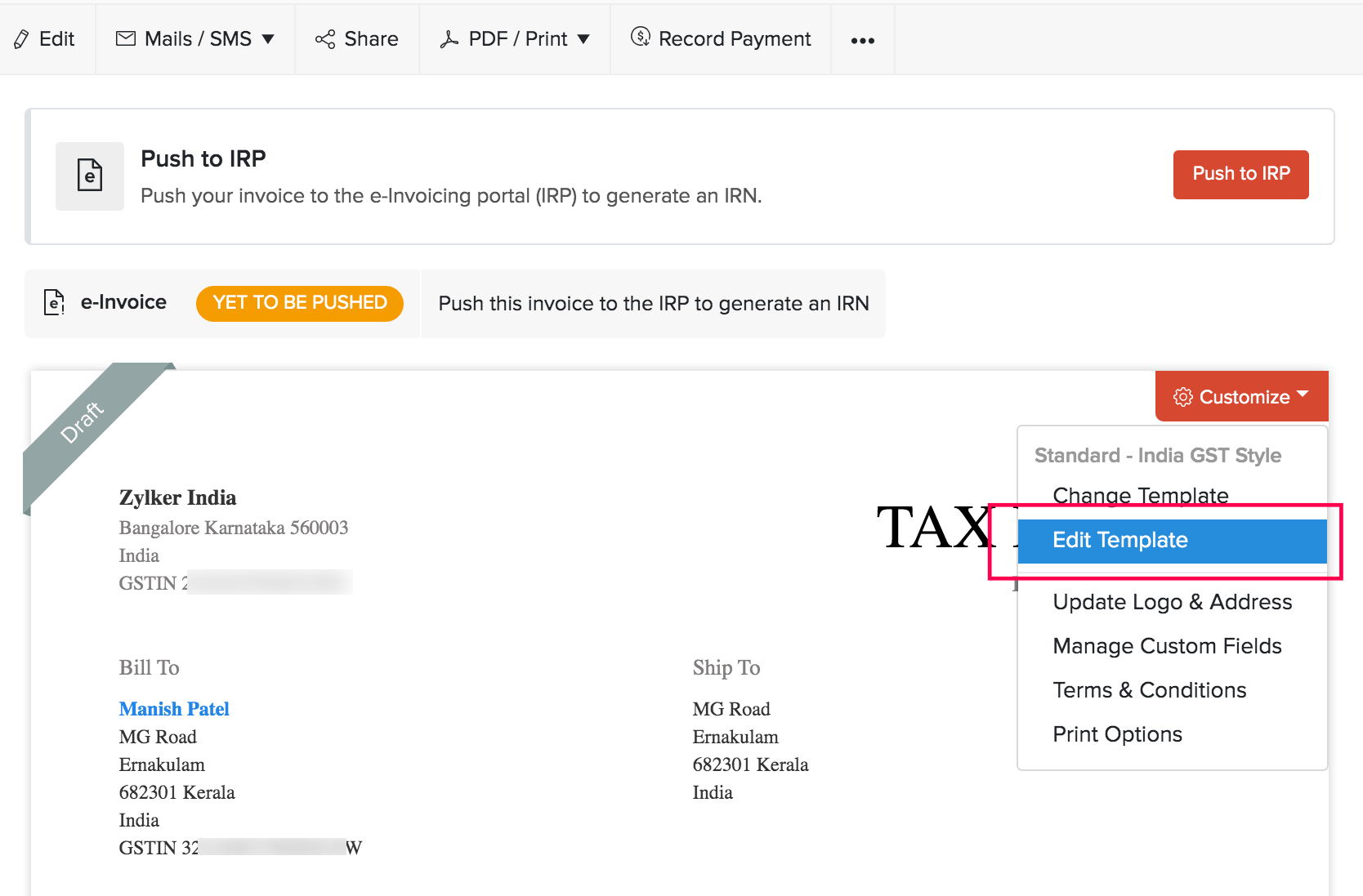
-
Click Continue in the pop up.
-
Click Footer in the left sidebar.
-
Scroll down to the e-Invoicing Details section.
-
Select the QR Code and IRN options. You can also include Ack No. and Ack Date.
-
Click Save.
Alternatively, you can also configure this option from the Templates section in Settings.
Pro Tip: To help with bulk actions, you can filter the invoices based on their e-Invoicing status in Zoho Inventory. To do this, go to the Invoices module and click All Invoices. From the list, you can either select Pushed for e-Invoicing or Yet-to-be pushed for e-Invoicing to view the corresponding list.
Bulk Push Invoices
You can save time and push multiple invoices to the IRP at once, using bulk actions in Zoho Inventory. Here’s how:
- Go to the Invoices module in the left sidebar.
- Click the All Invoices filter drop-down in the invoice list page.
- Select Yet-to-be pushed for e-Invoicing from the list of filters.
- Select the invoices that you want to push to the portal.
- Click the More button on the top and select the Push to IRP option from the drop-down.

Now, pushing the selected invoices to the IRP will be initiated. When successful, a QR code and IRN will be generated for all of them.
If any of these these invoices failed to be pushed to the IRP, you will be notified of it and an error summary will be sent to your (the user who initiates the push) email address that’s registered in Zoho Inventory.
Insight: Once an invoice has been pushed to the IRP and an IRN has been generated for it, you will not be able to edit any of its mandatory fields.
Cancel e-Invoices
You might want to cancel an e-Invoice if you’ve entered any incorrect values or for any other reason. This can be done in Zoho Inventory easily.
Warning: If you cancel an e-Invoice, the IRN associated with it will no longer be valid, and you’ll have to create a new IRN for the invoice.
Cancelling an e-Invoice depends upon the time lapsed since the IRN was generated:
Cancelling an e-Invoice within 24 hours
If you cancel an e-Invoice in Zoho Inventory within 24 hours of generating an IRN, it also gets cancelled in the IRP automatically.
To cancel an e-Invoice:
-
Go to the Invoices module in the left sidebar.
-
Select the e-Invoice that you want to cancel.
-
Click the Cancel e-Invoice button.
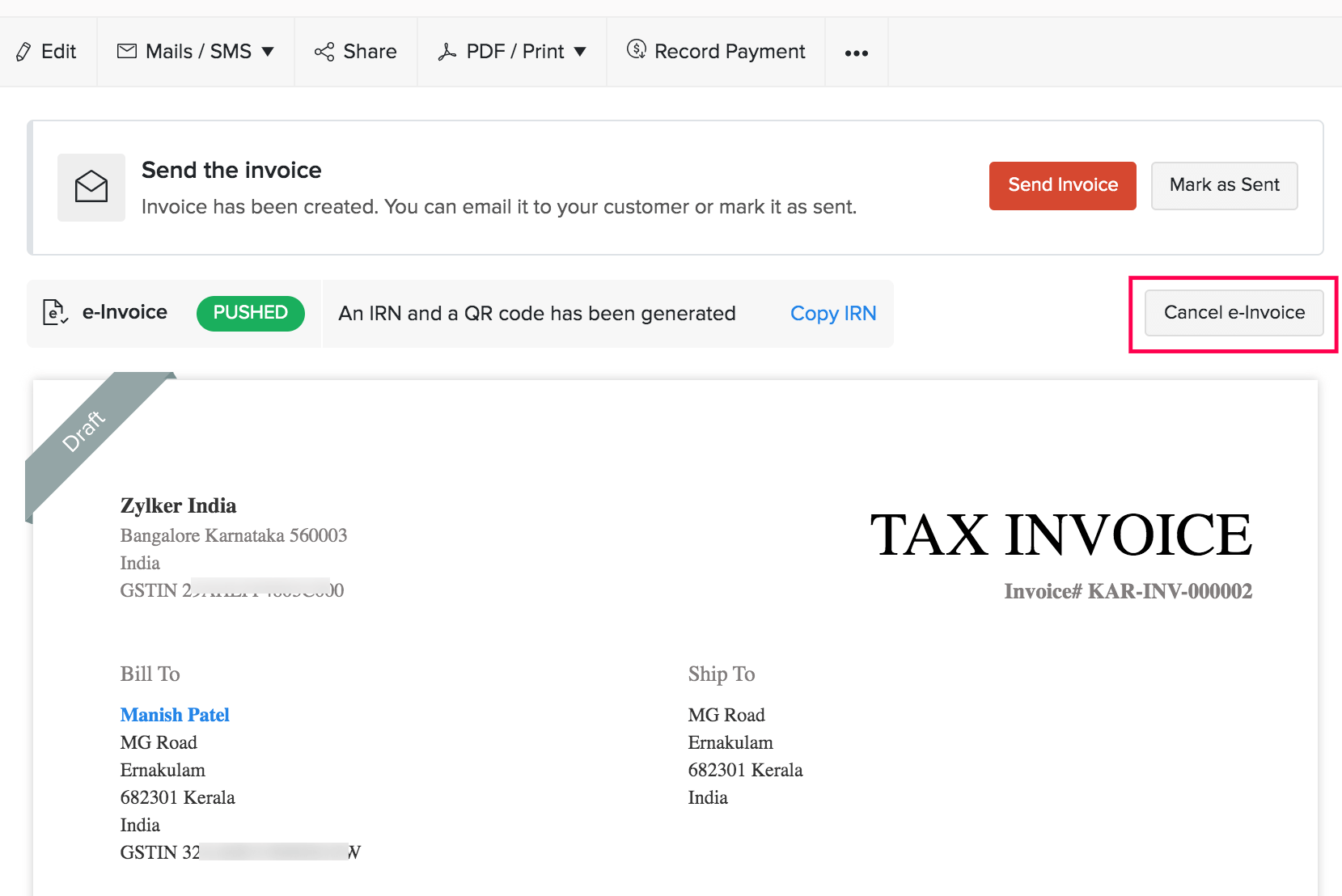
-
Select the reason for cancellation.
-
Enter any remarks, if needed.
-
Click Cancel e-Invoice.
Cancelling an e-Invoice after 24 hours
After 24 hours of pushing an invoice to the IRP successfully, the IRN generated will no longer be available in the IRP. So cancelling in Zoho Inventory will not cancel it in the IRP automatically.
Instead, you can mark the e-Invoice in Zoho Inventory as cancelled, and then go to the GST portal to cancel the IRN manually.
Here’s how you can do this:
- Go to the Invoices module in the left sidebar.
- Select the e-Invoice that you want to mark as cancelled.
- Click the Mark as Cancelled button.
- Enter the reason for cancelling this e-Invoice.
- Click Mark as Cancelled.
- Now, log in to the GST System.
- Navigate to E-invoices and then select Cancel.
- Enter the IRN of the e-Invoice you want to cancel.
- Enter the reason for cancellation and remarks.
- Click Submit.
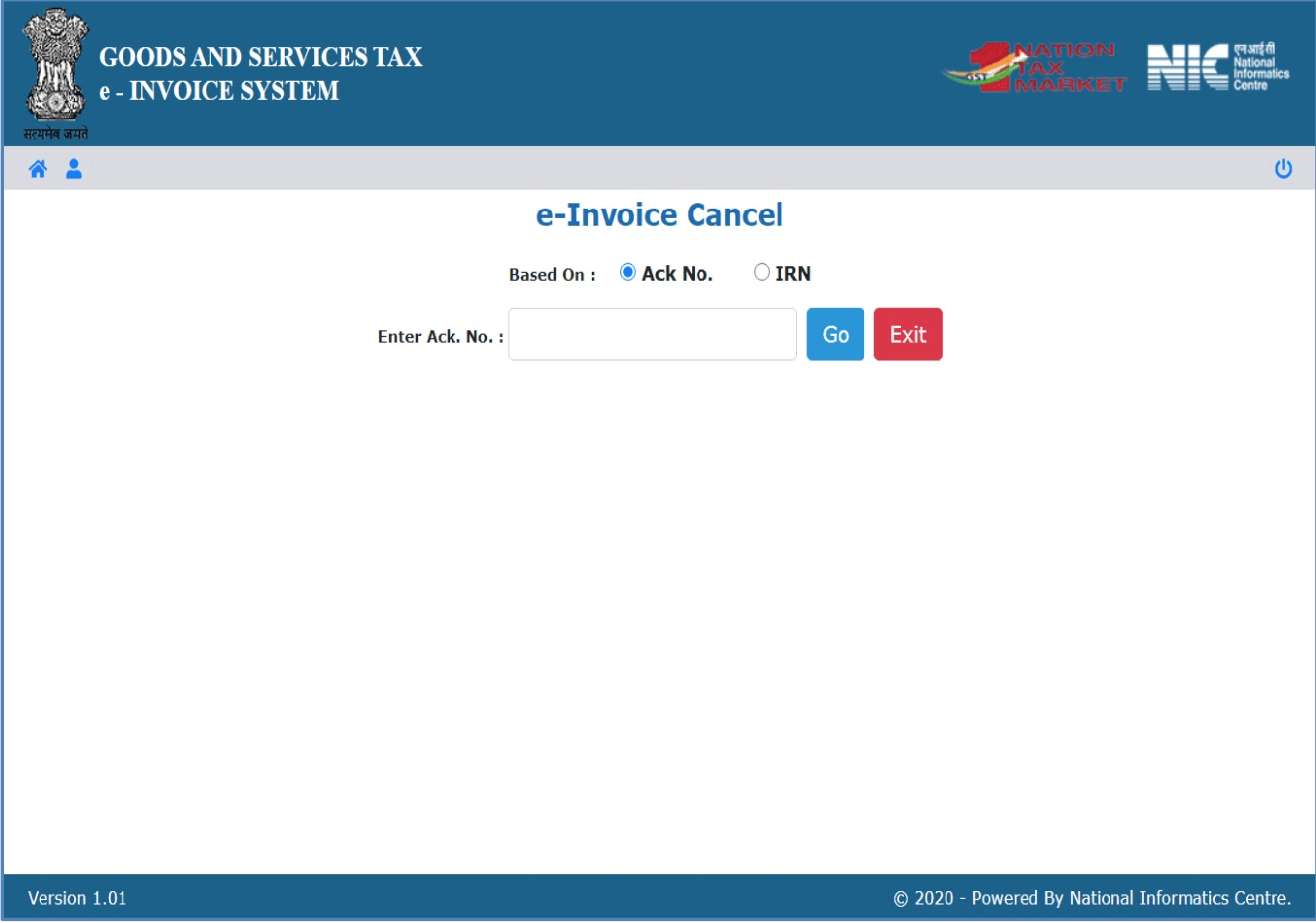
Once an e-Invoice has been cancelled/marked as cancelled in Zoho Inventory, its status will change to Void. If needed, you can clone this invoice, make the necessary changes, and then push this new invoice to the IRP.
Note: When an e-Invoice has been cancelled, you cannot generate a new invoice using the same invoice number.
If you require any assistance with e-Invoicing in Zoho Inventory, you can reach out to us at einvoicing-support@zohofinance.com.




